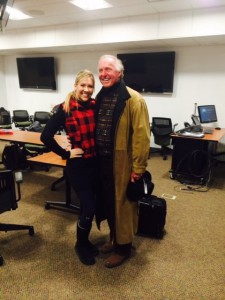A post from our student blogger Megan
See that title? Yep. That’s my philosophy. Since I became a licensed attorney in 2011 my outlook on life in general changed. Instead of accepting what life threw at me with little complaint— even if it made me uncomfortable or angry—I decided to radically change my reaction to how I dealt with the roller coaster we call life. No more would I be a passive life participant, I decided I would argue my beliefs. Patent law has reiterated my will to go to battle for what I want to passionately pursue. While the title might seem arrogant, believe me, it is not. There is a method to my madness. Let me explain.
It’s December here at Notre Dame and while the world is suiting up in light-up reindeer sweaters and toasting with egg nog toddies, the MSPL students are preparing to present their projects to their mentors. This activity is more commonly known to graduate students round the world as “defending your thesis”. This single phrase can send shock waves of terror through any sleep-deprived grad student from Hong Kong to Bemidji. But what do we have to fear? Well, everything. On a positive note, we have been preparing for this day for the last sixteen weeks. The time has come to show off what we have learned. The time has arrived. It is time to dazzle our advisors with the evidence of how hard we have worked.
Our job is to convince our mentors that we understand the underlying technology that they have developed. We are also charged with reconciling patent laws to the technology and then explaining this concept to them. Patentability as a legal theory is far more complicated than merely filling out an application and sending it to the United States Patent and Trademark Office, though. And explaining this concept to scientists and engineers can be daunting.
One of the biggest obstacles that we have all encountered in our patent application drafting journey is the fact that there are a lot of other related patents, publications, and information already existing on the inventions that we are trying to patent. Basic patent laws dictate that if the invention already exists within the public domain, patent protection will not be granted. The question becomes, how do you deal with this? More importantly, how do you explain this to your mentors? First things first, don’t give up. It is easy to say that you have an invention that does not deserve legal protection when you find something that looks similar to what you are trying to patent. When encountering this roadblock it is, in fact, a great time to really inspect the subject matter that you are trying to patent—it has to be new. Take a step back, reexamine your position and add more evidence to see if you can form a better argument regarding novelty. Even if you can show the slightest bit of inventive newness, then you are placing yourself in a much better position to earn a patent.
Life is full of rejection, though, and the patent prosecution process is no exception. So even if you believe that your invention is patentable, and you have satisfied all the statutory requirements within the four corners of your patent application, you might still receive a rejection. Once again, don’t give up. Argue against that rejection, present evidence, or amend your claims: whatever you choose to do, stand your ground and bolster your opinion. When you base your application around well-written claims, a strong specification, and a thorough search, you can argue everything.
As can see, my “argue everything” mentality is not just for lawyers that are backed into a corner. It’s also not just applicable to patent law, and it’s certainly not a blanket statement indicating that you should fight without merit. It is a justification that shows you are confident in your preparations and understanding. It’s a daily practice because “a great explanation can make our ideas come to life, invite people to care and be motivated to learn more.”[1] So get out there and argue everything.
[1] Lefever, Lee, The Art of Explanation: Making your Ideas, Products, and Services Easier to Understand, (John Wiley & Sons, Inc.), preface xi.

